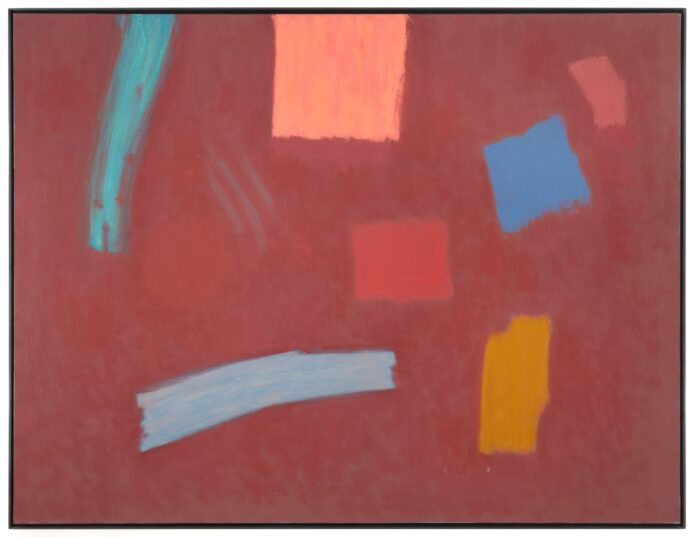Born in Connecticut, Kainen began his art career in New York but moved to D.C. in 1942 to take a curatorial job at the Smithsonian, where he worked until 1970. An art teacher as well as a curator, Kainen befriended aspiring local painters. Yet he never emulated those Washington colorists’ experiments with staining canvas with the vivid new acrylic pigments. Most of his pictures at Hemphill are oils, and the others employ gouache, sometimes supplemented by ink.
The gouaches are all from the early 1950s and show the influence of such European or Euro-American artists as Arshile Gorky (a Kainen acquaintance) and Paul Klee. The pictures suggest abstracted still lifes and landscapes, much as “Mr. Kafka” in the 1970s (rendered as both a painting and the show’s only print) hints at portraiture.
The ’80s canvases usually arrange boxes and bars, whether hard or spongier, on fields whose colors are contrasting but not brashly dissimilar. One standout, “Pilot IX,” exemplifies the appeal of Kainen’s style. The picture’s five rectangles float on denim-like blue and are in white, red and a barely different blue; each is subtly bordered by lines of crayon-like red. Pulpy yet precise, those red strokes merge form and hue as surely as any of Louis’s rivulets of poured color.
Jacob Kainen Through Oct. 28 at Hemphill Artworks, 434 K St. NW. hemphillfinearts.com. 202-234-5601.
Biographical vignettes from women’s history, Maremi Andreozzi’s detailed yet cryptic portraits conjure past lives through painstakingly rendered costumes and backdrops. Among her new paintings in Adah Rose Gallery’s “A Life Well Lived” are larger ones with more expansive settings. Yet even these pictures lack an attribute generally considered essential to portraits: faces. The Northern Virginia artist frames featureless black silhouettes with hats, veils, crowns and other signifiers of period and status.
Andreozzi’s recent subjects include a few generic women, such as three anonymous figures who represent the 146 workers (123 of them women) killed in the 1911 Triangle Shirtwaist Fire in Manhattan. Most often, though, she portrays specific and well-researched people: 18th-century Chinese Empress Dowager Chongqing, 7th-century Arabic doctor and teacher Rufaidah Al-Aslamia, and 18th-century midwife Gunston Nell, who was enslaved at George Mason’s Virginia estate, are just a few of the more than 50 women pictured in gemlike portraits.
The most striking of the artist’s new bigger paintings is the least characteristic of her established style. Fabiola, an aristocratic 4th-century Roman physician who became a Christian ascetic, is depicted nearly full length and posed dynamically in front of decorative red walls modeled on those of Pompeii. The portrait, like all of Andreozzi’s, is formal and symbolic, yet unusually vibrant. It conveys not just a life, but also liveliness.
Maremi Andreozzi: A Life Well Lived Through Oct. 22 at Adah Rose Gallery, 3766 Howard Ave., Kensington, Md. adahrosegallery.com. 301-922-0162.
Stephen Honicki is not a food stylist, but he has a flair for staging salads. The Upstate New York photographer, one of four contributors to Portico Gallery’s “Photo Credit,” artfully arranges leafy ingredients, usually in a round silver bowl. But in addition to photogenic flowers and fronds, he tosses in fruit peels, decaying vegetables and tattered food-related paper products. The pictures are from a series titled “The Beauty of Decay and Rebirth” in which only the decay is visible.
Philadelphia’s Charlie Welch photographs men in homemade masks to make eerie portraits that often feature polka dots on both the subject and the backdrop. These surrealistic images have a childlike aspect to them, so it’s hardly surprising that Welch also makes what he terms “messages to my eight-year-old self,” including the simple warning “run” spelled out amid a jumble of 3D plastic letters.
The local participants are Liza Linder and JS Adams, whose modes seem separated by about a century. Adams assembles what appear to be old photos, often of solemn bearded men, into collages; the images include translucent transparencies that overlap to suggest both depth and distance. Linder uses a smartphone camera, likely with a macro lens, to make small, close-up studies that flirt with abstraction. Her pictures depict tools, insects and ready-made circles, all arranged with stark formalism. Like Honicki, she places found objects in exquisite order.
Photo Credit Through Oct. 22 at Portico Gallery, 3807 Rhode Island Ave., Brentwood. portico3807.com. 202-487-8458.
In the dimly lighted room, testimony about the hardships of crossing Mexico toward the U.S. border is delivered in what sounds like a welter of voices. But on the platform just above floor level is a single face, replicated across more than a dozen cellphones. Each video image’s statement is slightly out of sync with the others, so as to yield a ragged chorus. “Arroyos,” Hubert Caron-Guay’s show at the IDB Staff Association Art Gallery, uses such simple devices to conjure the thousands headed north.
Based on a decade of documenting immigration, the Montreal artist and filmmaker’s installation has just three elements: the bank of cellphones, a projected-video montage and a wall map. The last, a replica of one painted by migrants at a shelter in Mexico, charts major northbound rail routes and locations designated as “risk areas.” There are, unsurprisingly, many such places.
The room’s darkness complements the video footage, much of which was shot at night alongside railroad tracks or from moving trains. Walking through the shadowy gallery conjures the confusion and dislocation felt by travelers journeying through an unknown land in hope of reaching another country that’s equally alien but, perhaps, safer. For a few moments, visitors may get the sensation of being in a risk area. The feeling is, mercifully, short-lived. But an awareness of migrants’ experience of it lingers.
Arroyos Through Oct. 19 at IDB Staff Association Art Gallery, 1300 New York Ave. NW (13th Street entrance). idbstaffassociationartgallery.org. 202-623-3635.



